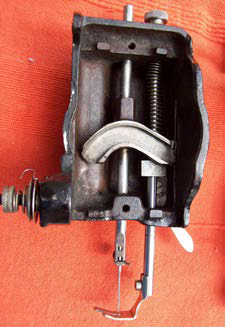The Ismak sewing machine, a 1920s failure

Fig. 3: The flywheel of the ISMAK machine is similar in construction to that of the IDEAL chainstitch machine

Fig. 1: The Vickers sewing machine of the 1920s
After the end of the First World War in 1918 a lot of munitions factories found themselves with lots of machine tools and skilled workers but a dearth of orders. These conditions led to the launch of several new sewing machines.
One major munitions firm was Vickers who launched the 'Vickers' sewing machine (Fig. 1) as yet another clone of the Singer 128. It met with some success because it was well made (Vickers were good engineers) and it could replace in the market Singer 128 clones made in Germany. Some, however, were not in the same league.
One unsuccessful venture was the 'Ideal Sewing Machine Company Ltd.' launched in 1919 to make and market Leslie Salter's 'Ideal' chainstitch machine. The story of this little nickel plated oscillating hook machine was told in ISMACS News 107 (June 2012).

Fig. 2: The ISMAK sewing machine, front view
To survive, the Company needed a 'proper' lockstitch machine. A simple rotary hook with a cased stationary bobbin machine was designed and patented in 1922 (British patent 30/844/22).
The machine needed a name! The Daily Mail for October 23rd 1922 carried an advertisement by the Ideal Sewing Machine Co. Ltd., of 66 Broad Street Avenue, London EC2, stating that they had awarded a cash prize of one hundred pounds to a Mrs K. M. Kemp of 26 Sylvan Avenue, Wood Green, London, for suggesting the name 'ISMAK',- for Ideal Sewing MAchine Kompany?
Thus was born the ISMAK sewing machine (Figures 2-8). Presumably, it was manufactured by the same company that made the Ideal chainstitch machine. Like the chainstitch machine, the construction is crude and it is, therefore, hardly surprising that the company was soon in trouble.

Fig. 4: An underneath view showing the massive cast iron bed
If you wanted a British made machine other than a Singer from Clydebank there were quality products available from Jones and Vickers (Bradbury gave up sewing machines in the early 1920s). Also, German companies were back in production with good quality machines at budget prices.
The Ideal Sewing Machine Co. Ltd. did not stand a chance. On March 6th 1924 there appeared in the Brisbane Courier, an advertisement by a company called ACB who stated that through their London Agent they had a batch of 100 ' ISMAK' machines for sale at the 'remarkable price of £3/10/-' (£3.50) whereas they were 'honestly worth £7/7/-' (£7.35). The sell-off of surplus machines had begun and, by 1925, the Company had closed down.
Why did the ISMAK fail? Firstly, it was not manufactured in sufficient numbers to warrant 'interchangeable manufacture' so that the parts appears crude and poorly finished. Secondly, the basic mechanics are poor engineering: the successful rotary hook machines all had the hook moving faster when picking up the loop from the needle and slower when retaining the loop.

Fig. 6: The complete rotating hook and bobbin assembly

Fig. 7: The needle bar and presser foot assembly

Fig. 5: The rotating hook and the hinged ring to keep the bobbin case in place
In the case of the Wheeler & Wilson 'No. 8' and 'D 9', and their derivatives, the lower shaft is speeded up and slowed down by the drive configuration, and in the case of the W&G 'No. 10' and the Singer 101 and 201 series the hook shaft rotates at thrice or twice the rate of the needle drive shaft.
So, forget minor quibbles such as the lack of a top tension release and forget the lack of service agents, the ISMAK was dead in the water!
Editor's note: I have only seen a handful in 30 years compared with many tens of the Ideal chainstitch.

Fig. 8: ISMAK machine in a wooden case






